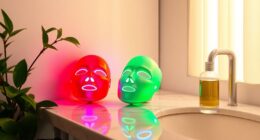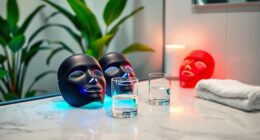Protect your eyes from harmful LED light by understanding its risks. Prolonged exposure to blue light can cause eye strain, headaches, and even retinal damage. High levels of blue light from poor quality LED lights may lead to fatigue and impact overall eye health. Choose warm white LED lights instead of cool white ones to minimize negative effects. Use blue light filters to protect your eyes. Remember the 20-20-20 rule: every 20 minutes, look at something 20 feet away for 20 seconds. By following these guidelines, you can shield your eyes from the detrimental effects of harmful LED light and maintain good eye health.
Key Takeaways
- Use warm white LED lights to reduce harmful blue light exposure.
- Consider blue light filters to protect eyes from LED light damage.
- Implement the 20-20-20 rule to prevent eye strain.
- Take regular eye care breaks to maintain good vision health.
- Opt for blue light blocking glasses for enhanced eye protection.
Risks of Bad LED Light
Excessive exposure to harmful LED light poses notable risks to eye health. Bad LED lights emit high levels of blue light, which can lead to various issues such as eye strain, headaches, and disrupted sleep patterns. The harsh blue light from these sources can cause fatigue and impact overall eye health negatively.
Additionally, prolonged exposure to bad LED light may even result in retinal damage over time. Studies have indicated a concerning link between bad LED light exposure and an increased risk of age-related macular degeneration, a leading cause of vision loss in older adults.
To mitigate these risks, it's essential to choose eye-friendly LED lights with warm color temperatures. By opting for such lighting options, individuals can significantly reduce the potential harm posed by bad LED light exposure and safeguard their eye health in the long run.
Understanding Blue Light Exposure
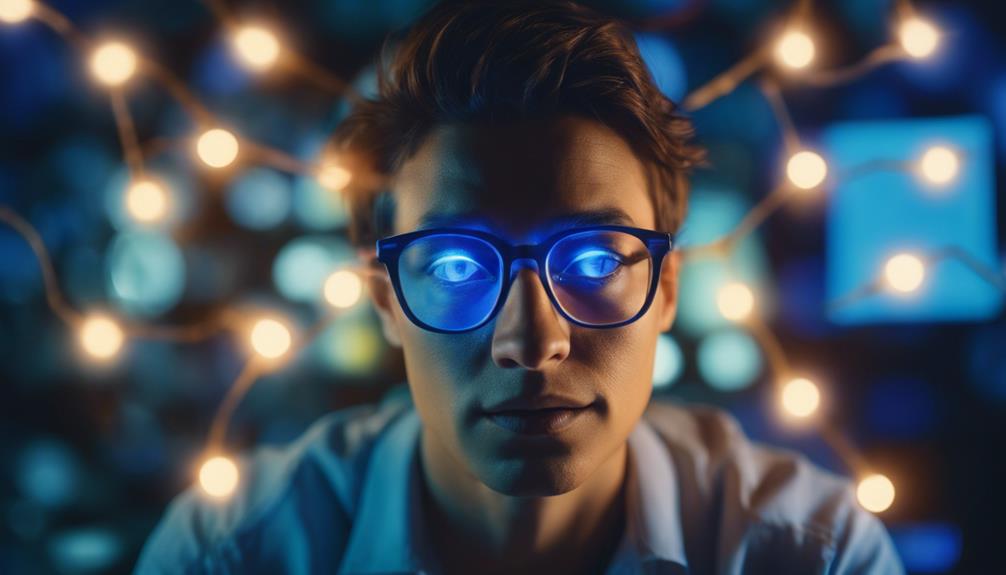
Essential
Blue light exposure from LED lights poses significant risks to eye health, including retinal damage and disruptions in sleep patterns. This type of light, emitted by various digital devices and artificial sources, can potentially harm the delicate retinal cells over time.
Prolonged exposure to blue light may lead to symptoms like eye strain, headaches, and fatigue. Research has also indicated a correlation between blue light exposure and the development of eye diseases.
To maintain good eye health, it's essential to limit exposure to blue light from LED sources. Taking breaks from screens, using blue light filters or glasses, and adjusting lighting settings can help reduce the negative impact of blue light on the eyes.
Understanding the effects of blue light exposure is essential for individuals to protect their eyes and overall well-being.
Impact on Eye Health

LED light exposure can have detrimental effects on eye health, including potential harm to the retina and disruption of the natural circadian rhythm. Blue light emitted by LED lights can lead to various issues related to eye damage and overall well-being.
Here are some key points to take into account:
- Prolonged exposure to blue light from LEDs may result in retinal damage and eye strain.
- Chronic LED light exposure has been associated with headaches, fatigue, and potential eye diseases.
- The choice of warm white LED lights over cool white ones can help minimize the harmful effects of blue light on the eyes.
- It's essential to take steps to limit overexposure to blue light, particularly before bedtime, to protect your eyes from potential LED light damage.
Importance of Blue Light Filters

Blue light filters are essential for shielding the eyes from harmful blue light, which can lead to various eye issues over time.
By using specialized lenses with blue light filters, individuals can greatly reduce their risk of developing conditions like age-related macular degeneration.
Customized premium lenses offer tailored protection, ensuring that the eyes receive beneficial light while minimizing exposure to damaging blue light.
Benefits of Filters
The utilization of specialized filters in lenses offers a significant advantage in shielding the eyes from harmful effects of certain types of light. Blue light filters are particularly beneficial for eye protection, especially when considering prolonged exposure to screens and LED lighting. Premium lenses with these specialized filters can be tailored to individual needs, ensuring the best protection for each person.
The benefits of filters, especially blue light filters, include reducing eye strain, improving visual comfort, protecting the retina from damage caused by blue light, enhancing contrast, reducing glare, and improving overall visual clarity.
- Reduce eye strain
- Improve visual comfort
- Protect the retina from damage
- Enhance contrast and reduce glare
Usage Tips
Proper utilization of blue light filters in lenses is essential for safeguarding your eyes from the adverse effects of modern light sources. Blue light emitted from LED lights can lead to eye strain and potential long-term damage if not properly managed. By incorporating blue light blocking technology into your lenses, you can effectively protect your eyes and guarantee excellent eye care. These filters work by selectively filtering out harmful blue light while allowing beneficial light to pass through, reducing the risk of discomfort and retinal cell damage. Investing in premium lenses customized for blue light protection can greatly enhance your visual comfort and overall eye health.
| Blue Light Filter Benefits | Description | Impact |
|---|---|---|
| Reduced Eye Strain | Minimizes discomfort during prolonged screen time. | Enhances visual comfort. |
| Protection from Damage | Safeguards delicate retinal cells from harm. | Prevents potential long-term eye damage. |
| Customized Protection | Tailored solutions for individual blue light exposure. | Optimizes eye care based on unique needs. |
Implementing the 20-20-20 Rule
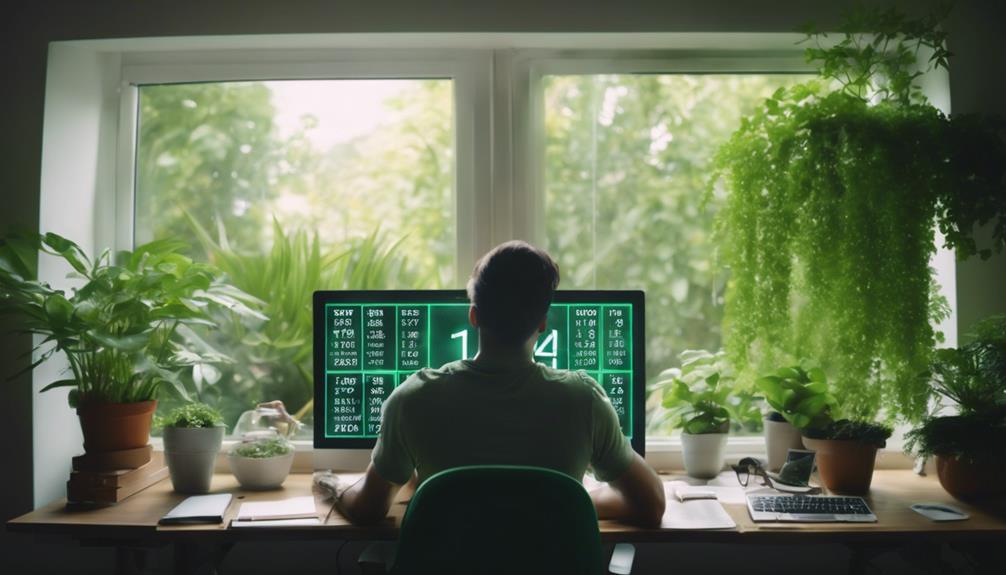
Implementing the 20-20-20 rule involves taking regular breaks to look at a distant point to reduce eye strain from prolonged screen use. This rule is particularly beneficial in combating digital eye strain caused by exposure to blue light emitted by LED lights.
By following this rule, individuals can alleviate symptoms like dry eyes, headaches, and fatigue associated with excessive screen time. Additionally, practicing the 20-20-20 rule consistently can contribute to overall eye health improvement and enhance comfort during screen activities.
- Looking at a distant object relaxes eye muscles.
- Reducing screen time minimizes the impact of blue light exposure.
- Preventing eye strain helps maintain productivity and focus.
- Implementing the 20-20-20 rule is beneficial for both children and adults.
Proper Lighting Conditions

Reducing exposure to blue light by adjusting lighting conditions is key to maintaining eye health and comfort during screen use. When using LED lights, opt for warm white options with a color temperature below 3000K to minimize the amount of blue light emitted.
Positioning LED lights at a safe distance of at least 20 inches from your eyes can help reduce direct glare, lowering the risk of eye damage. Utilizing adjustable LED dimmers allows you to control brightness levels, creating a more comfortable lighting environment for prolonged screen time.
To further protect your eyes, consider installing light shields or diffusers to reduce harsh glare and reflections from LED fixtures. Additionally, choosing LED lights with a high color rendering index (CRI) can provide accurate color representation while reducing eye strain.
Benefits of Eye Care Breaks
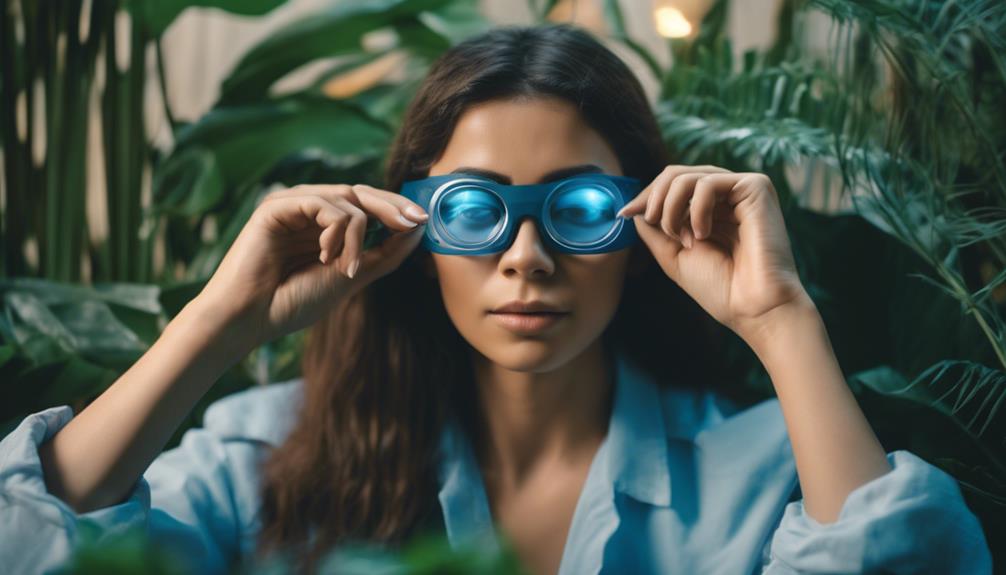
Regular breaks from screen time can reduce eye strain and discomfort, leading to increased productivity levels.
Following the 20-20-20 rule, which involves looking away from screens every 20 minutes and focusing on a distant object for 20 seconds, can help prevent eye fatigue.
Implementing these short breaks throughout the day can contribute to better overall eye health and reduce the risk of digital eye strain.
Eye Strain Prevention
Taking regular breaks from screens, as recommended by the 20-20-20 rule, significantly reduces eye strain and helps prevent digital eye strain symptoms. To prevent eye strain effectively, individuals should follow these practices:
- Follow the 20-20-20 rule: Look at something 20 feet away for 20 seconds every 20 minutes.
- Adjust screen brightness: Dim the brightness of screens to reduce strain on the eyes.
- Maintain proper posture: Sit at an appropriate distance from screens and make sure the screen is at eye level.
- Blink frequently: Blinking helps moisten the eyes, reducing the risk of dry eyes and discomfort.
Increased Productivity Levels
By incorporating regular eye care breaks into their daily routine, individuals can experience a significant boost in productivity levels. Taking breaks to follow the 20-20-20 rule, which involves looking at something 20 feet away for 20 seconds every 20 minutes, can help reduce eye strain caused by prolonged exposure to blue light from screens.
This practice not only prevents digital eye strain symptoms like dry eyes, headaches, and blurred vision but also enhances focus and concentration. Studies have shown that by giving their eyes regular breaks, individuals can combat fatigue, maintain peak vision health, and improve overall work performance and efficiency.
Prioritizing eye care breaks can lead to heightened productivity levels and a more comfortable work environment.
Better Overall Eye Health
Individuals can greatly enhance their overall eye health by prioritizing regular eye care breaks throughout their daily activities. Taking breaks from screens can reduce eye strain and fatigue, improving eye health.
Following the 20-20-20 rule, which involves looking 20 feet away every 20 minutes for 20 seconds, can help prevent digital eye strain. Outdoor play is beneficial for children's eye health and can reduce the risk of nearsightedness.
Maintaining proper screen habits, such as holding screens at a distance and blinking frequently, can protect eyes from the effects of blue light exposure. Good posture while using screens can prevent muscle tension and headaches, contributing to better overall eye health.
Choosing Blue Light Blocking Glasses
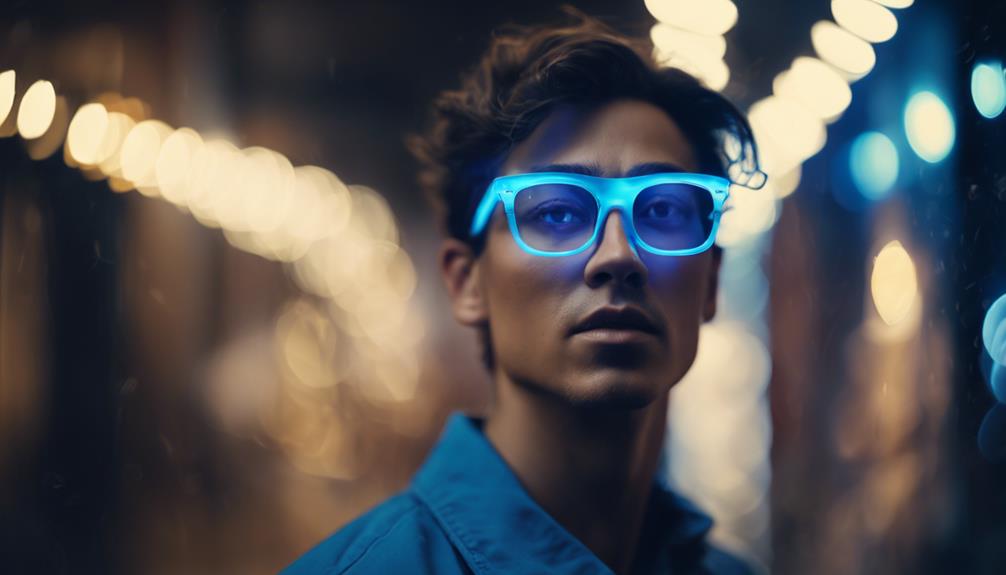
Blue light blocking glasses offer a vital solution for reducing exposure to harmful blue light emitted by LED lights. These specialized glasses have lenses designed to filter out a significant amount of blue light, helping to protect eyes from potential damage caused by excessive screen time.
By wearing blue light blocking glasses, individuals can alleviate symptoms like eye strain, headaches, and sleep disturbances associated with prolonged exposure to blue light. Choosing the right pair of blue light blocking glasses is essential in ensuring maximum protection and relief.
These glasses not only enhance eye comfort but also play a role in improving sleep quality by reducing the disruption of the body's circadian rhythm. When selecting blue light blocking glasses, it's important to take into account factors such as lens quality, frame design, and personal preferences to find the most suitable pair that meets individual needs and effectively minimizes exposure to harmful blue light.
Limiting Screen Time

To protect their eyes from the negative effects of excessive screen time, individuals can benefit from implementing strategies to limit their screen time exposure.
- Following the 20-20-20 rule can help reduce eye strain by looking 20 feet away every 20 minutes for 20 seconds.
- Outdoor play is beneficial for children to decrease the risk of nearsightedness caused by excessive screen time.
- Teaching kids proper screen habits, like maintaining a safe distance and blinking often, can protect their eyes.
- Encouraging good posture while using screens can prevent muscle tension and headaches in children.
Frequently Asked Questions
How to Protect Eyes From LED Lights?
To protect eyes from LED lights, one can choose warm white LEDs below 3000K to reduce blue light exposure.
Using computer glasses with blue light filters lessens eye strain during screen time.
Positioning LED lights to minimize direct glare helps prevent eye discomfort.
Installing dimmer switches allows control over brightness.
Also, software adjusting screen color temperature can reduce blue light exposure in the evenings.
These strategies promote healthier eyes when using LED lights.
How Can You Protect Your Eyes From Harmful Light?
In order to protect one's eyes from harmful light, it's crucial to follow a few key practices. These include using specialized lenses with blue light filters, taking breaks from screens, adjusting screen brightness, opting for warm white LED lights, maintaining a proper distance from LED lights, and considering using no-glare lenses.
Can LED Lights Irritate Your Eyes?
LED lights can irritate eyes due to emitting blue light, which can lead to eye fatigue, headaches, and blurred vision. Prolonged exposure may disrupt sleep patterns and potentially damage the retina.
Taking breaks from staring at LED screens can help reduce eye strain and irritation. It's advisable to use blue light filters or adjust screen settings to minimize the impact of LED light on eye health.
How Can I Protect My Eyes From Too Much Light?
To protect their eyes from excessive light exposure, individuals can adopt various strategies. These may include:
- Using specialized lenses with blue light filters
- Taking regular breaks from screens
- Adjusting screen brightness
- Opting for warm-colored LED lights
- Maintaining a safe distance from light sources
- Considering the use of no-glare lenses
These measures can help minimize eye strain, reduce blue light exposure, and enhance eye comfort in different environments.
Conclusion
In summary, safeguarding your eyes from harmful LED light is essential for maintaining peak eye health. By recognizing the risks of blue light exposure and implementing simple strategies like using blue light filters and following the 20-20-20 rule, you can reduce the negative impact on your eyes.
Keep in mind, limiting screen time and choosing blue light blocking glasses can help you avoid potential eye strain and discomfort. Take care of your eyes now to prevent issues later on. Stay informed and stay protected!



